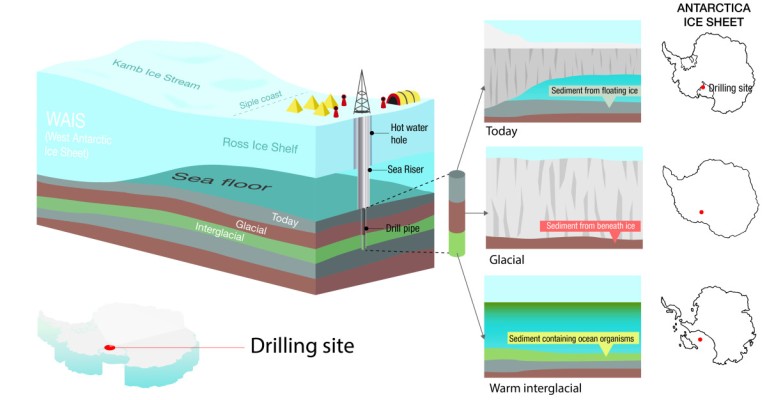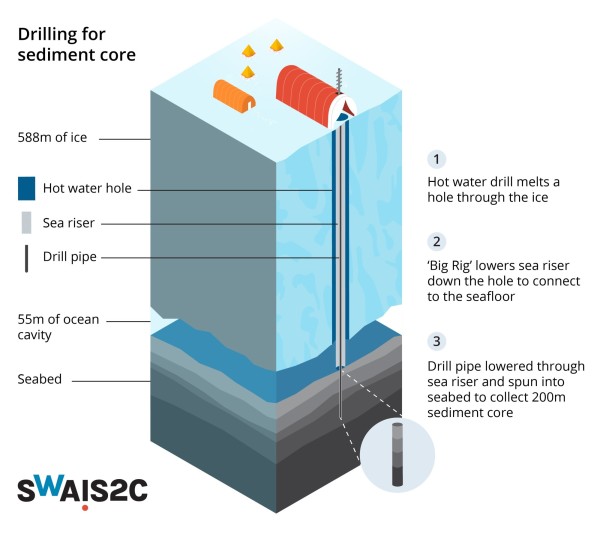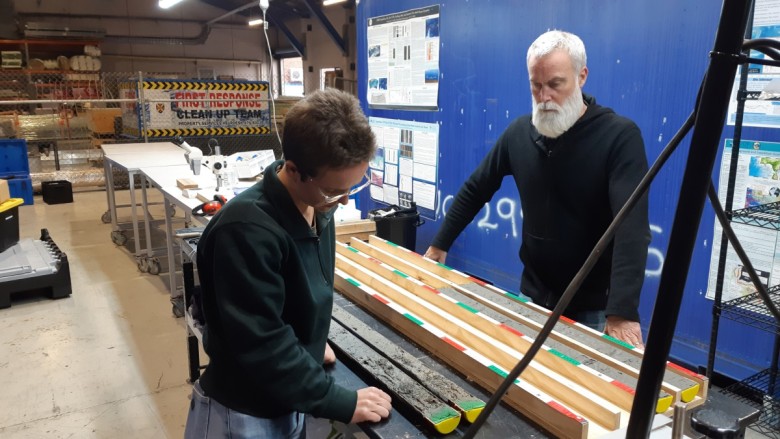West Antarctica is largely ice-covered, which means its geological archives are hidden beneath a massive layer of ice. Drilling down into the ice is vital for accessing valuable records of past climate and ice sheet behaviour.
Our ambitious drilling and research programme is seeking to obtain the sedimentary history at two locations near the modern grounding zone of the West Antarctic Ice Sheet.
We will drill at two locations along the Siple Coast of West Antarctica, where the West Antarctic Ice Sheet lifts off the seafloor and begins to float. Kamb Ice Stream is located beneath the floating ice shelf, close to the grounding zone of the West Antarctic Ice Sheet. Crary Ice Rise ice sits directly on bedrock.
No one has ever drilled deep into the Antarctic seabed at a location so far from a major base, and so close to the centre of the West Antarctic Ice Sheet. The thin layer of ocean beneath the ice shelf at the study site has been accessed a few times, but a deep sediment core has never been recovered. We are trying to get beneath the ice shelf to access the seabed and give ourselves enough of a window to extract those sediment cores before the hole in the ice freezes up.

Drilling
A team of engineers from Te Herenga Waka – Victoria University of Wellington and Earth Sciences New Zealand have developed a new ice and sediment drilling system.
We will transport this drill system hundreds of kilometres across the Ross Ice Shelf to the Siple Coast. We will first use Te Herenga Waka’s hot water drill to melt a hole through the ice shelf (more than 500 m). At KIS3 we will lower a sea-riser through the hole and the 55 m ocean cavity below. Then a purpose-built light-weight sediment coring system (The Antarctic Intermediate Depth Drill, AIDD) will drill to the seafloor. This transportable system is capable of recovering about 200 metres (660 feet) of sediment from beneath the seafloor in places where the combined depth of the ice shelf (or sea ice) and water column is over 1,000 metres (3,380 feet) thick.
You can’t just buy a drill like this off the shelf. It’s custom-built for the challenge. We are bringing together lots of different parts and pieces and adapting them to address our problem, which comes with a lot of unique challenges and workarounds. We have to carefully consider which spare parts we need to take, what we can, or absolutely cannot, do without. Because it’s not like you can pop down to the shop to get the part you need. Also, when everything is set up and operating, it must all fit into a tent that is only 15 metres long and 8 metres wide.
We will use the Antarctic Intermediate Depth Drill system (AIDD system) to recover sediment cores from under the Ross Ice Shelf. The system refers to:
-
a glass reinforced epoxy riser
-
a MP1000 portable diamond core drill (sometimes called the drill rig), with custom developed accessories
-
the hot water drill will get integrated with the diamond core drill, where the hot water drill supplies hot water as a drilling fluid

Studying the cores
Once the cores have been recovered, they will be flown back to New Zealand’s Antarctic hub at Scott Base and shipped to the Otago Repository for Core Analysis (ORCA) at Otago University in Dunedin, New Zealand. The cores will ultimately be stored at Oregon State University's Marine and Geology Repository in the United States, where they will be available to the global research community for ongoing research.
Data from the cores will be used to reconstruct past ocean temperatures and sea ice extent, and determine ice shelf and ice sheet response to prehistoric climate variability and periods of past warmer-than-present conditions, including during intervals of elevated atmospheric CO2 and temperature. These observations of past environmental conditions will be used by the team’s numerical modellers, who use computers to conduct experiments that help examine and understand interactions between the Earth’s crust, oceans, atmosphere, and ice and how these interactions evolve as the climate cools and warms.
Every metre of sediment we acquire is going to allow numerous studies. We are currently sorting through the various projects that our scientists are proposing and to ensure the right people get the right samples.

